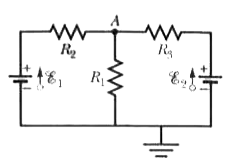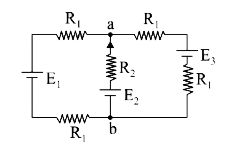In Fig 27-50,ε=24.0V,R1=2000Ω,R2=3000ΩandR3=4000Ω. What are the potential differences (a) VA−VB (b) VB−VC (c) VC−VDand(d)VA−VC? 
The correct Answer is:(a) 10.5 V (b) 3.00 V; (C) 10.5 V (d) 13.5V
Topper's Solved these Questions
- CIRCUITSBOOK - RESNICK AND HALLIDAYCHAPTER - CIRCUITSEXERCISE - Practice Questions (Single Correct Choice Type)
33 Videos
- CIRCUITSBOOK - RESNICK AND HALLIDAYCHAPTER - CIRCUITSEXERCISE - Practice Questions (More than One Correct Choice Type)
12 Videos
- CIRCUITSBOOK - RESNICK AND HALLIDAYCHAPTER - CIRCUITSEXERCISE - Checkpoints
7 Videos
- CENTER OF MASS BOOK - RESNICK AND HALLIDAYCHAPTER - CENTER OF MASS EXERCISE - Practice Questions (Integer )
4 Videos
- CIRCULAR MOTIONBOOK - RESNICK AND HALLIDAYCHAPTER - CIRCULAR MOTIONEXERCISE - CHECK POINTS
6 Videos
Similar Questions
In Fig 27.37, ε1=1.00V,ε2=3.00V,R1=4.00Ω,R2=2.00Ω,R3=5.00Ω, both batteries are deal. What is the latest which energy is dissipated in (a) R1,(b)R2and(c)R3? What is the power of (d) battery 1 and (e) ballery 2? Is energy being absorbed or provided in (f) battery and (g) battery 2?
View SolutionFind the currents in the Y connection of 3 resistances R1=10Ω, R2=20Ω and R3=30Ω. When the terminals of R1 , R3 and R3 are maintained at potentials V1 = 10V, V2=6V and V3 = 15V.

View Solution
Knowledge Check
In the R1=10Ω,R2=20Ω,R3=40ΩR4=80Ω and VA=5V,VB=10V,Vc=20V,VD=15V The current in the resistance R1 will be
 A0.4A toward OB0.4A away from OC0.8A toward OD0.8A toward O
A0.4A toward OB0.4A away from OC0.8A toward OD0.8A toward O
In Fig. 27-44, ε1=8.00V,ε2=12.0V,R1=100Ω,R2=200Ω,R3=300Ω. One point of the circuit is grounded (V =0). What are the (a) size and (b) direction (up or down) of the current through resistance 1, the (c) size and (d) direction (left or right) of the current through resistance 2, and the (e) size and (f) direction of the current through resistance 3? (g) What is the electric potential at point A?

View SolutionIn the uniform electric field shown in figure, find :
a. VA−VD
b. VA−VC
c. VB−VD
d. VC−VD

View SolutionIn the uniform electric field shown in figure, find :
a. VA−VD
b. VA−VC
c. VB−VD
d. VC−VD

View SolutionIn the circuit shown, the potential differences, V1 ( between A and B ) and V2 ( between C and D ), are

View SolutionIn the circuit shown, the potential differences, V1 ( between A and B ) and V2 ( between C and D ), are

View SolutionFor the circuit shown, with R1=1.0Ω,R2=2.0Ω,E1=2VandE2=E3=4V the potential difference between the points ‘a’ and ‘b’ is __________(in V)

View SolutionIn Fig 27-56, the ideal batteries have emf emf12=200Vandε2=50V and the resistances are R1=3.0ΩandR2=2.0Ω. If the potential at P is 100 V, what is at at Q?

View Solution
